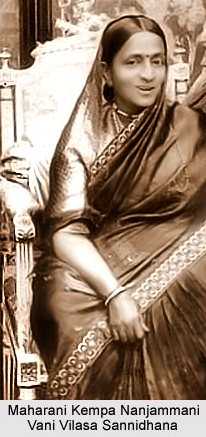 Maharani Kempa Nanjammani Vani Vilasa Sannidhana, also known as Maharani Kempa Nanjammani of Vani Vilasa Sannidhana, was the wife of Chamaraja Wodeyar IX and served as regent from 1894 to 1902. She was the queen of Maharaja Chamaraja Wodeyar IX and mother of Nalwadi Krishnarajendra Wodeyar, Maharaja of the princely state of Mysore. Kempa Nanjammani was selected to act as head of the Kingdom of Mysore as the ruler was a minor at the time. She occupies a towering place as any other ruler in the history of the princely state of Mysore.
Maharani Kempa Nanjammani Vani Vilasa Sannidhana, also known as Maharani Kempa Nanjammani of Vani Vilasa Sannidhana, was the wife of Chamaraja Wodeyar IX and served as regent from 1894 to 1902. She was the queen of Maharaja Chamaraja Wodeyar IX and mother of Nalwadi Krishnarajendra Wodeyar, Maharaja of the princely state of Mysore. Kempa Nanjammani was selected to act as head of the Kingdom of Mysore as the ruler was a minor at the time. She occupies a towering place as any other ruler in the history of the princely state of Mysore.
Early Life of Maharani Kempa Nanjammani
Maharani Kempa Nanjammani of Vani Vilasa Sannidhana was born in the year 1866 to Narase Urs and Kempananjammanni of Kalale. She got married to Maharaja Chamaraja Wodeyar on 26th May 1878. Her role as the Maharani-regent and as the mother of Krishna Raja Wodeyar IV and her contributions for the development of the community and the people of Mysore has made her one the most respected and renowned rulers of the country. In the former princely state of Mysore Maharani Kempa Nanjammani, she was considered as an exceptional gem.
Rule of Maharani Kempa Nanjammani
In 1884, Maharaja Chamaraja Wodeyar IX and Maharani Kempa Nanjammani had their first child Nalwadi Krishnarajendra Wodeyar. Later the royal couple had another son Kanteerava Narasimharaja Wodeyar and 3 daughters as well. In the year 1894 Chamarajendra Wodeyar got severely affected by diphtheria and died in Calcutta (now Kolkata), after ruling Mysore for only 13 years. During the time of his death, the young prince Krishna Raja Wodeyar IV was still a minor. The death of the king of Mysore was deprecated by the British administration as an Imperial defeat. Consequently, Maharani Kempa Nanjammani was selected as Maharani-regent or Queen Regent of Mysore to fill the void.
She held the designation for 8 years and served the Kingdom of Mysore with self-confidence, discipline devotion, distinction and dignity. She was supported by the services of Diwan Sir K. Seshadri Aiyar and her Secretary Sir M. Kanatha Raj Urs, who was her brother. The sincere efforts of Maharani-regent developed the state of the kingdom. The efficient and effective administration helped in attaining advancement in every field. During her reign various progressive steps were taken such as laying of foundation stone of Victoria Hospital in Bangalore (now Bengaluru), generation of electricity from Kaveri River, construction of Mari Kanave valley anicut, expansion of new regions in Mysore, water supply through pipes, construction of the new palace and others.
Maharani Kempa Nanjammani Vani Vilasa Sannidhana also focused on the improvement of women`s education and helped in developing the Maharani`s College. She was a follower of Hinduism, but respected other faiths as well.
Retirement of Maharani Kempa Nanjammani
When her son Nalwadi Krishnarajendra Wodeyar attained the age of majority, she retired from the esteemed designation. Maharaja Krishna Raja Wodeyar IV ascended the throne on 8th August 1902, which ended the reign of Maharani-regent. Kempa Nanjammani Vani Vilasa Sannidhana died at the age of 69 on 7th July 1934, after a brief illness.
Honours of Maharani Kempa Nanjammani
Due to the various contributions of Maharani Kempa Nanjammani for the progress of the princely state of Mysore, the British administration honoured her with a `C.I.` Moreover, there are several structures in old Mysore area that contain Vani Vilasa, including Maternity Hospital, Ladies Club, Water Works, Road, Bridge, Girls High School and others, which commemorate her memory event at the present age.



















